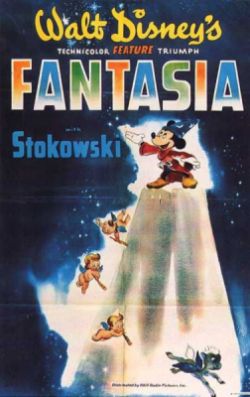Fantasia (1940)
Fantasia is a third animated movie produced by Walt Disney in 1940. Fantasia was first released as a theatrical roadshow between 1940 and 1941. The film was not a success by the time until some parts of the movie were tweaked. The film has been reissued multiple times from its original footage.
Fantasia is a cartoon that has few segments. Over 1,000 artists and technicians were used in the making of Fantasia[1], which features more than 500 animated characters[2].
Out of several segments of Fantasia, The Pastoral Symphony is one that caught attention. This particular segment is seen to be racist because of its characters. However, four shots from The Pastoral Symphony were later removed in late 1960 because two characters were shown in a racially stereotyped manner.
The Pastoral Symphony
According to Ward Kimball, the animators were "extremely specific on touchy issues"[3]. The Pastoral Symphony takes place in the serene shadow of Mount Olympus backed up by “Sixth Symphony”, Beethoven’s music.
Controversy
In the original release of Disney’s Fantasia in 1940, the Pastoral Symphony featured a black centaurette named Sunflower and a second named Otika appeared briefly during the procession scenes with Bacchus and his followers[4].
Sunflower is one of the minor protagonists from The Pastoral Symphony. She is appeared to be a very young Centaurette because, physically, she is smaller than other Centaurettes in the scene. She was seen as a small dark-skinned centaur with braided hair. She was pictured having a big, exaggerated lip and hair, and the body of a donkey. Her role in the movie was to assist the other centaurettes as they got ready, basically serving them[5]. Sunflower was first seen on the left-hand side of the screen holding the hoof of a pretty white-haired beauty. She was seen to be polishing the hoof of pretty white-haired Centaurette.
In another scene, another character similar to Sunflower named Otika appeared to be rolling the red carpet for Bacchus. Sunflower was the one who unrolled the red carpet up the steps to the throne of Bacchus. The other donkey unicorns, follow behind her and desperately try to guide the unsteady Bacchus up to his seat. Sunflower remained behind the seat to balance him but the attempt failed as Bacchus loses balance and fell down. Sunflower seemed to be upset, she ran around in circles with seemingly scared with both hands on the sides of the head and never seen ever again.
Sunflower and Otika are stereotypical caricatures of an African American female child of the time, as evidenced by her distinctive hairstyle in which parts of her hair are separated by hair-bands into multiple stubby, spike-like bunches similar in size that are often used as a stereotypical visual in films to define an African American child. It is also mentioned that the action of polishing the hoof reminiscent of the African American shoeshine boys of the time.[6].
References
- ↑ Hente, David (October 29, 1991). "'Fantasia' marks anniversary with video". The Southeast Missourian. Retrieved January 16, 2011.
- ↑ "'Fantasia' returning in complete version". The Montreal Gazette. May 8, 1943. Retrieved February 12, 2011.
- ↑ https://en.wikipedia.org/wiki/Fantasia_(1940_film)#cite_ref-mont1943_40-0
- ↑ Cohen, p. 69.
- ↑ https://www.ginnydi.com/blog/2017/7/6/loving-disney-without-loving-racism-fantasias-sunflower
- ↑ https://cartoonresearch.com/index.php/lost-fantasia-the-disappearance-of-sunflower/


